19
The semiconductor light emitting devices include the semiconductor light emitting diode (LED), Nixie tubes, symbol tubes, and matrix tubes. In fact, each of the luminous unit of these tubes is a light emitting diode.
The Light Emiting Diode (LED): Where did it come from?
Catalog
I Light Emitting Principles | |
II Parameters | 2.1 Limit Parameters |
2.2 Electric Parameters | |
III Classifications | 3.1 According to the Light Color |
3.2 According to the Characteristics of the Light-out Surface | |
3.3 According to the Structure | |
3.4 According to Luminous Intensity and Working Current | |
IV Applications | |
V Detection | 5.1 Detection of Ordinary Light-emitting Diodes |
5.2 Detection of Infrared LED | |
I Light Emitting Principles
The light-emitting diode is made of a III-IV compound such as GaAs (gallium arsenide), GaP (gallium phosphide), GaAsP (gallium arsenide phosphide), and its core is the PN junction. Therefore, it has the I-N characteristics of a general P-N junction, which include forward conduction, reverse cutoff, and breakdown.
In addition, it has luminescent properties under certain conditions. At the forward voltage, electrons are injected into the P region from the N region, and holes are injected into the N region from the P region. And a part of the minority carriers entering the other area is combined with the majority carriers to emit light, as shown in Figure 1.
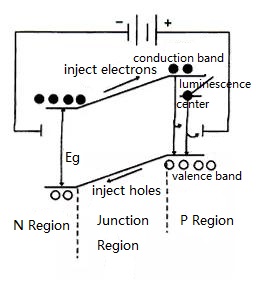
Figure 1.
Assuming that luminescence occurs in the P region, the injected electrons are directly combined with the holes of valence band or they are first captured by the luminescent center and then combined with the holes to emit light. In addition to this luminescent composite, some electrons are captured by the non-luminous center (this center is near the middle of the conduction band and the intermediate band), and then combined with the holes. The energy released by these electrons each time is not large, which can not form visible light.
The larger the ratio of the composite quantity of luminescence to the composite quantity of non-luminescence is , the higher the photon efficiency will be. Since the composition emits light in the diffusion region of minority carriers, light is generated only within a few μm of the surface of the PN junction.
Theory and practice show that the peak wavelength λ of light is related to the energy gap(Eg) of the semiconductor material in the light emitting region, ie
λ≈1240/Eg(mm)
The unit of Eg in the formula is electron volt (eV). If visible light with a wavelength between 380 nm(purple light) and 780 nm(red light) is produced, the Eg of the semiconductor material should be between 3.26eV and 1.63 eV. Light longer than the wavelength of red light is infrared light. There are now infrared, red, yellow, green and blue light emitting diodes, but the blue-light diodes are of high cost and expensive, so they are not commonly used.
II Parameters
2.1 Limit Parameters
Allowable Power Consumption Pm
The maximum value of the product of the forward DC voltage applied to both ends of the LED and the current flowing through it. If Above this value, the LED gets hot and damaged.
Maximum Forward DC Current IFm
The maximum forward DC current allowed to be applied. Exceeding this value can damage the diode.
Maximum Reverse Voltage VRm
The maximum reverse voltage allowed to be applied. Above this value, the LED may be damaged by breakdown.
Working Environment topm
The range of ambient temperature where the LED can work normally. Below or above this temperature range, the LED will not work properly and its efficiency will be greatly reduced.
2.2 Electric Parameters
Spectral Distribution and Peak Wavelength
The light emitted by a certain LED is not of single wavelength. The wavelength is generally as shown in Figure 2.
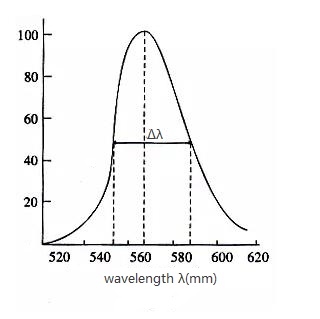
Figure 2.
It can be seen from the figure that the light intensity of a certain wavelength λ0 in the light emitted by the LED is the largest, and its wavelength is the peak wavelength.
Luminous Intensity IV
The luminous intensity generally refers to the luminous intensity in the direction of the normal line (for the cylindrical LED, it’s called axis). If the radiation intensity in this direction is (1/683) W/sr, then the emitting light is 1cd (candela). Since the general LED has a small luminous intensity, the unit of the luminous intensity is commonly used as a unit of mcd.
Spectral Half-width Δλ
It indicates the spectral purity of the diode. It refers to the interval between the two wavelengths corresponding to the 1/2 peak intensity in Figure 3.
Half-value Angle θ 1/2 and Viewing Angle
θ 1/2 means an angle between the direction in which the luminous intensity value is half of the axial intensity value and the axial direction of the light emission (normal direction). The viewing angle (or half power angle) is two times of the half-value angle.
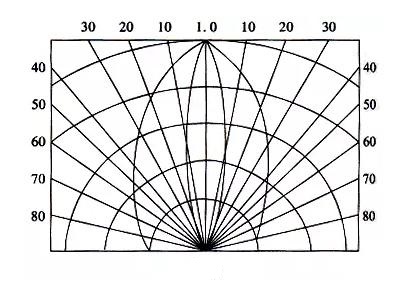
Figure 3.
Figure 3 shows the angular distribution of the luminous intensity of two different types of LEDs. The coordinates of the mid-perpendicular line (normal) AO are the relative luminous intensities, which is the ratio of the luminous intensity to the maximum luminous intensity. Obviously, the relative luminous intensity in the normal direction is 1, and if the angle from the normal direction is larger, the relative luminous intensity is smaller. The value of half-value angle and viewing angle can be obtained from this graph.
Forward Working Current If
It refers to the forward current value when the LED is normally illuminated. In practical use, the IF should be selected below 0.6·IFm as needed.
Forward Working Voltage VF
The working voltage given in the parameter table is obtained at a given forward current, which is generally measured at IF = 20 mA. The forward working voltage VF of the LED is 1.4~3V. And as the outside temperature rises, the VF will drop.
V-I Characteristics
The relationship between the voltage and current of the light-emitting diode can be represented by Figure 4.
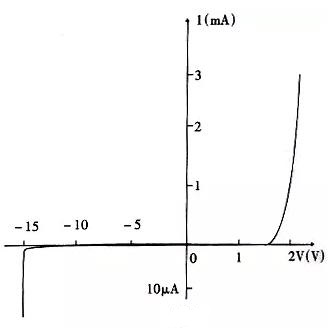
Figure 4.
When the forward voltage is below a certain value (threshold), the current is extremely small and the diode does not emit light. When the voltage exceeds a certain value, the forward current rapidly increases with the voltage and the diode illuminates. From the V-I curve, parameters such as forward voltage, reverse current and reverse voltage of the diode can be obtained.
III Classification
3.1 According to the Light Color
According to the light color of the light emitting diodes, it can be divided into red, orange, green (subdivided into yellow-green, standard green and pure green), blue light light emitting diodes and so on. In addition, some light-emitting diodes include chips of two or three colors.
The light-emitting diodes of the above various colors can also be classified into four types of colored transparent, colorless transparent, colored scattering and colorless scattering according to whether the light-emitting place is doped with or without a scattering agent, colored or colorless. Scattering LEDs are used for indicator lights.
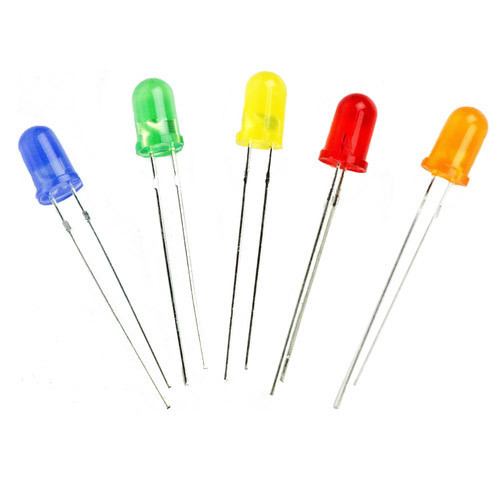
Different Colors of LEDs
3.2 According to the Characteristics of the Light-out Surface
According to the characteristics of the light-out surface of the luminous tubes, the light-emitting diode can be divided into round lamps, square lamps, the rectangular lamps, the surface light-emitting tubes, the lateral tubes, the surface-mounted micro tubes, and the like. The round lamps are subdivided into types of φ2 mm, φ4.4 mm, φ5 mm, φ8 mm, φ10 mm, and φ20 mm according to the diameter. In foreign countries, a light-emitting diode with diameter of φ3 mm is generally recorded as T-1; one with diameter of φ5 mm is recorded as T-1 (3/4); and one with diameter of φ4.4 mm is recorded as T-1 (1/4).
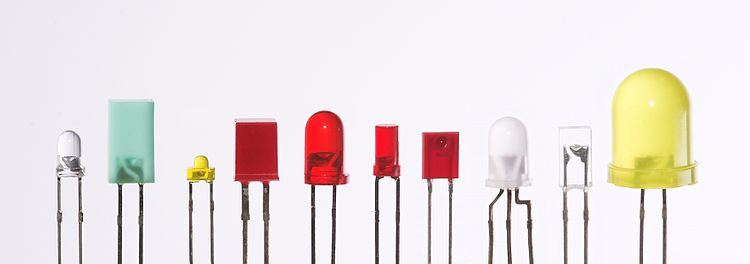
Different Structures of LEDs
The angular distribution of the circular luminous intensity can be estimated from the size of half-value angle. And the LED can be further divided into three categories from the angular distribution of luminous intensity:
High-directivity Type
It is usually a pointed epoxy package or a metal reflector package with no scattering agent. The size of its half-value angle is from 5°to 20 ° or less. Since it has a high directivity, it can be used as a partial lighting source, or form an automatic detection system combined with a light detector.
Standard Type
It's usually used as indicator light, and its half-value angle is of 20 °to 45 °.
Scattering Type
This is a type of indicator light with a large viewing angle, the half-value angle is of 45° to 90° or more, with a large amount of the scattering agent.
3.3 According to the Structure
According to the structure of the light-emitting diode, there are type of full epoxy packing, epoxy packing with a metal base, epoxy packing with a ceramic base, and glass packing.
3.4 According to Luminous Intensity and Working Current
According to luminous intensity and working current, there are LEDs with ordinary brightness (lighting intensity <10mcd), ultra-high brightness LEDs (lighting intensity >100mcd). Light-emitting diodes with luminous intensity between 10 and 100mcd are called high brightness LEDs.
Generally, the working current of the LED is between ten mA and several tens of mA, and the working current of the LED with low current is below 2 mA , of which the brightness is the same as that of the ordinary luminous tubes).
IV Applications
Since the color, size, shape, luminous intensity, and transparency are different, the light-emitting diode should be appropriately selected according to actual requirements.
LEDs are widely used in a variety of electronic devices and can be used as power indicators, level indicators or low-light sources. Infrared LEDs are often used in remote controls for televisions and video recorders.
4.1 A circuit of a miniature flashlight with a high-brightness or ultra-high-brightness light-emitting diode is shown in Figure. 5. In the figure, R is a current limiting resistor, which help make the current of the LED lower than the maximum allowable current IFm.
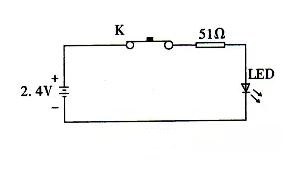
Figure 5.
4.2 Figures 6(a), (b), and (c) show the indicating circuit of DC power supply, the rectified power supply, and the AC power supply .
In Figure (a) R ≈(E-VF)/IF;
in Figure (b) R≈(1.4Vi-VF)/IF in Figure (b);
and in Figure (c) R≈Vi/IF in Figure (c).
Vi is the effective value of the AC voltage.

Figures 6.
4.3 Level indicating circuit of single LED. At the output of the amplifier, oscillator or pulse digital circuit, LEDs can be used to indicate whether the output signal is normal, as shown in Figure 7. R is a current limiting resistor. The LED may only illuminate when the output voltage is greater than the threshold voltage of the LED.
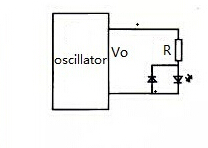
Figures 7.
4.4 Single LED used as a low voltage stabilivolt. When the LED is forward-conducting, its current changes very rapidly with the voltage, with the voltage-regulator characteristics of ordinary stabilivolts. The stabilized voltage of the LED is between 1.4 and 3V. VF should be selected as requirements, as shown in Figure 8.
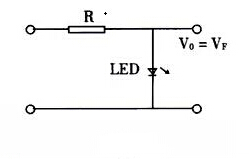
Figure 8.
4.5 Level meter. At present, LED level meters are widely used in stereo equipment. It uses luminous tubes to indicate the output signal level. The different numbers of LEDs that emit light indicating the change of the output level.
Figure 9. shows a level meter composed of five light emitting diodes. When the input signal level is low, it does not emit light at all. When the input signal level increases, LED1 first lights up, and then LED2 lights up.
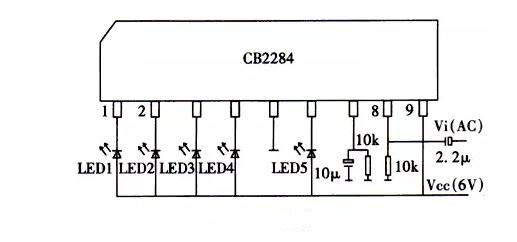
Figure 9.
V Detection
5.1. Detection of Ordinary Light-emitting Diodes
5.1.1 Test with a Multimeter
Using a pointer multimeter with a gear of ×10kΩ can roughly judge the quality of the LED. Normally, the forward resistance value of the diode is tens of ohms to 200 kΩ, and the value of the reverse resistance is ∝. If the forward resistance value is 0 or ∞, and the reverse resistance value is small or 0, the LED is easily damaged. As the gear of ×10kΩ can not provide a large forward current to the LED, this method can not detect the actual light condition of the LED,
However, using two pointer multimeters (preferably of the same model) can better check the illumination of the LEDs. Use one wire to connect the positive terminal of one multimeter to the negative terminal of the other. The remaining negative leads are connected to the positive pole (P zone), and the remaining positive leads are connected to the negative pole (N zone) of the illuminated tube. Set the two multimeters to “×10Ω”. Under normal circumstances, the diode will glow normally after being turned on. If the brightness is very low, or there is even no light, you can set both multimeters to “×1Ω”. But if it is still dark or even not emitting light, it means that the LED is of poor performance or damaged. It should be noted that the two multimeters should not be set to “×1 Ω” at the beginning, or excessive current will damage the LED.
5.1.2 Measure with External Power Supply.
The optical and electrical characteristics of the LED can be accurately measured with a stabilized power supply of 3V or two dry cells in series and a pointer or digital multimeter.
The connecting circuit is shown in Figure 10. If the measured value of VF is between 1.4 and 3V, and the brightness of the light is normal, the light is normal. If VF=0 or VF≈3V , and there is no light, the light-emitting tube is broken. VR=IFR
5.2 Detection of Infrared LED
Infrared light-emitting diodes emit infrared light of 1 to 3 μm, which is invisible for human beings. Usually, the transmit power of a single infrared light-emitting diode is only a few mW, and the angular distribution of the luminous intensity of different types of infrared LEDs is also different. The forward voltage drop of an infrared LED is generally from 1.3 to 2.5V.
Because the infrared light is invisible, the aforesaid detection method of LED with visible light can only determine whether the forward and reverse electrical characteristics of the PN junction are normal, rather than determine whether the illumination condition is normal or not. For this reason, it is best to prepare a photosensitive device (such as a 2CR or 2DR-type silicon photocell) as a receiver. Use a multimeter to measure the changes in the voltage across the battery, and determine whether the infrared LED emits infrared light after adding an appropriate forward current. Its measurement circuit is shown in Figure 11.
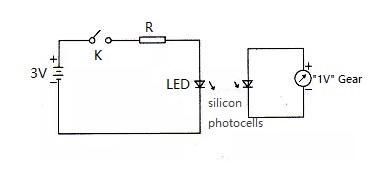
Figure 11.
You May Also Like:
Versions, Development Platforms, and Installation Sequence of Device Driver
Parameters, Identification and Applications of Zener Diode
Features, Developemnt Trends and Disadvantages of Wireless Power Transfer
Ordering & Quality
| Photo | Mfr. Part # | Company | Description | Package | Qty |
|
MAX6804US29D2+T | Company:Maxim Integrated | Remark:Processor Supervisor 2.93V 2.85V to 5V 4-Pin(3+Tab) SOT-143 T/R | Package:TO-253-4, TO-253AA |
MAX6804US29D2+T Datasheet |
In Stock:8225 Inquiry |
Inquiry |
|
AGLN060V5-CSG81 | Company:Microsemi Corporation | Remark:IC FPGA 60 I/O 81CSP | Package:81-WFBGA, CSBGA |
AGLN060V5-CSG81 Datasheet |
In Stock:130 Inquiry |
Inquiry |
|
MCF52110CEP66 | Company:NXP | Remark:IC MCU 32BIT 128KB FLASH 64QFN | Package:64-VFQFN Exposed Pad |
MCF52110CEP66 Datasheet |
In Stock:1128 Inquiry |
Inquiry |
|
RD0306T-H | Company:ON Semiconductor | Remark:DIODE GEN PURP 600V 3A TP | Package:TO-251-3 Long Leads, IPak, TO-251AB |
RD0306T-H Datasheet |
In Stock:6530 Inquiry |
Inquiry |
|
MCIMX31LCVKN5D | Company:NXP / Freescale | Remark:IC MPU I.MX31 532MHZ 457MAPBGA | Package:457-LFBGA |
MCIMX31LCVKN5D Datasheet |
In Stock:147 Inquiry |
Inquiry |
|
MC9S08GT16ACFBE | Company:NXP / Freescale | Remark:IC MCU 8BIT 16KB FLASH 44QFP | Package:QFP |
MC9S08GT16ACFBE Datasheet |
In Stock:746 Inquiry |
Inquiry |
|
CY7C131E-55NXI | Company:Cypress Semiconductor | Remark:SRAM 8Kb (1Kb x 8) 55ns Dual-Port SRAM | Package: |
CY7C131E-55NXI Datasheet |
In Stock:96 Inquiry |
Inquiry |
|
RC0603FR-071KL | Company:Yageo | Remark:RES SMD 1K OHM 1% 1/10W 0603 | Package:SMD |
RC0603FR-071KL Datasheet |
In Stock:39061200 Inquiry |
Inquiry |
|
S9S12G128F0CLH | Company:NXP | Remark:IC MCU 16BIT 128KB FLASH 64LQFP | Package:64-LQFP |
S9S12G128F0CLH Datasheet |
In Stock:5046 Inquiry |
Inquiry |
|
MMB02070C2201FB200 | Company:VISHAY | Remark:RES SMD 2.2K OHM 1% 1W 0207 | Package:SMD |
MMB02070C2201FB200 Datasheet |
In Stock:63360 Inquiry |
Inquiry |